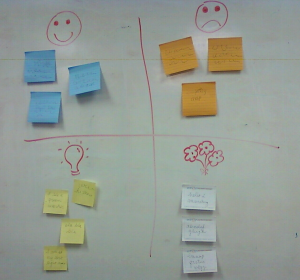Learning Matrix

Goal
Materials
Instructions
Strategy
Encourage players to continue thinking of ideas for each quadrant, even after all the sticky notes have been posted or the quadrants have filled up. Write the additional comments around the topic images to maintain the positioning of the original notes.
A good facilitator is necessary for this game in order to keep everyone focused. If the project team leader does not feel comfortable in this position, it is best to hire a neutral facilitator. This must be someone who can gain the team’s trust and create an environment in which participants feel comfortable sharing their ideas.
Key Points
This exercise allows you to perform iteration retrospective analysis while maintaining a positive environment. By organizing your thoughts, you can lay out your plan for improvement and discover how to enhance your project for the future. Collaborate to identify what should be repeated, changed, or tried, and to congratulate team members for a job well-done.
How to Play
1. Before your meeting, create a 2×2 matrix. Draw a picture in each quadrant to represent a different aspect involved in your retrospective analysis:
Quadrant 1: Frown face for aspects you disliked, should be changed
Quadrant 2: Smiley face for aspects you liked, should be repeated
Quadrant 3: Light bulb for new ideas to try
Quadrant 4: Bouquet: people you appreciated
2. Provide players with plenty of sticky notes and markers. Allow 5-10 minutes for participants to individually write down their ideas for the four topics on separate notes.
3. After all players are done writing their ideas, ask them to present their sticky notes to the group and post them on the designated sections of the chart.
4. Narrow down the notes to a few requiring immediate attention. Give each player 6 – 10 dot stickers, which they will use to dot vote for the ideas they believe are top-priority. Resolve ties by discussing which note is more pressing or having another dot vote. Count all the votes to determine which ideas should be focused on. Narrowing ideas down is important, as it allows the team to concentrate on priorities and increases the chance of effective improvements being made.
5. Move the notes around to reflect the order of priority. Collaborate to evaluate how these ideas can be used to enhance your next iteration and discuss where you can begin making improvements.
Attachments
- Learning-matrix-cover.webp
Background
Author
Gamestorming is a set of co-creation tools used by innovators around the world.
More about author